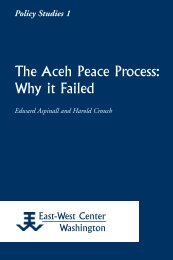Constructing Papuan Nationalism: History, Ethnicity ... - ScholarSpace
Constructing Papuan Nationalism: History, Ethnicity ... - ScholarSpace
Constructing Papuan Nationalism: History, Ethnicity ... - ScholarSpace
- No tags were found...
You also want an ePaper? Increase the reach of your titles
YUMPU automatically turns print PDFs into web optimized ePapers that Google loves.
10 Richard ChauvelNetherlands agreed to transfer the administration of Papua to Indonesia,after the brief interposition of a United Nations Temporary ExecutiveAuthority (UNTEA). In turn, Indonesia agreed that <strong>Papuan</strong>s could determinetheir own future through an “Act of Free Choice” held in 1969. Inpractice, this ratification was carefully orchestrated by the Indonesianauthorities, as <strong>Papuan</strong> nationalists had feared would happen. 9Nevertheless, on November 19, 1969, the United Nations GeneralAssembly “noted” the results of the “Act of Free Choice” in resolution2504 (Chauvel and Ikrar Nusa Bhakti 2004: 12–13, 18–21).The construction of <strong>Papuan</strong> history represented in these resolutionshad developed after the fall of Suharto, during what some observers havecalled the “<strong>Papuan</strong> Spring” that extended from mid 1998 to November2000 (van den Broek and Szalay 2001; Chauvel 2002). This version of historyreflected not only deeply held convictions but also an assessment ofthe political agendas that would be most effective in negotiations with thegovernment and in mobilizing support in Papua. The <strong>Papuan</strong> Springbegan in July 1998, when a coalition of NGO and church leaders, adatfigures, and intellectuals and officials formed the FORERI (ForumRekonsiliasi Masyarakat Irian Jaya, Forum for Reconciliation in Irian Jaya),which developed a political program and reinterpreted the history ofPapua’s integration into Indonesia. FORERI’s establishment had been precededa few weeks earlier by flag raisings and demonstrations in Biak,Jayapura, Sorong, Wamena, Manokwari, and elsewhere in Papua. The military’ssuppression of the Biak demonstration, leaving numerous dead,suggested Suharto’s ways of dealing with separatist dissent had not disappearedwith his resignation (Rutherford 1999: 40), and the formation ofFORERI was a response to that fact.However, in the <strong>Papuan</strong> nationalist consciousness, the events of 1998were not the beginning of <strong>Papuan</strong> nationalism. In their view, there is adirect continuity from the nationalism of 1961 down through the years ofIndonesian rule that ends finally in the post-Suharto revival. In otherwords, the desire to be separate from Indonesia was not new, but something<strong>Papuan</strong>s had long wanted. Indeed, according to this view, <strong>Papuan</strong>swere integrated into Indonesia against their stated preferences and againsttheir better judgment. Thus, the <strong>Papuan</strong>s of the post-Suharto era weredemanding not a new independence, but rather for Indonesian and internationalrecognition of the sovereignty that the <strong>Papuan</strong>s had established in1961. According to this version of history, the legitimacy of <strong>Papuan</strong> inde-
















